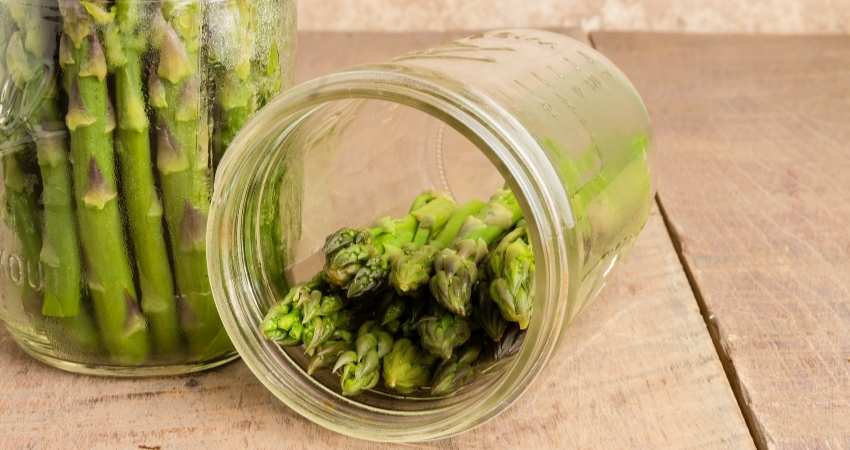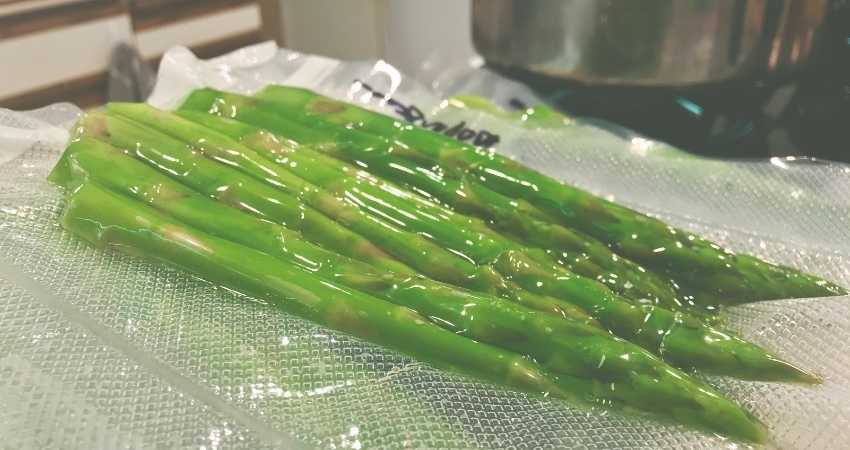This Is How Long You Can Keep Fresh Asparagus
Preventing asparagus from going bad is ideal so they’re available to you whenever you want. Therefore, how long can you keep fresh asparagus?
You can keep asparagus fresh for about one week if they are stored properly in the refrigerator. Storing them straight up, with the bottoms trimmed and soaking in water, will keep them fresh the longest. In the freezer, asparagus can last up to one year.
If you want to enjoy your asparagus for longer than a week, you can use some other methods. This blog post will inform you which methods and how to keep them for up to one year.
How Long Can You Keep Fresh Asparagus?

As a Certified Health Coach many clients ask me about food storage including asparagus. Also, I purchase and consume it almost every week. Therefore, I have researched this topic in the past and present. Let’s examine the storage methods closely.
You can keep fresh asparagus for only about 7 days. After that they become moldy, slimy and should be thrown away. It’s a shame when such a beneficial food goes to waste ((USDA: Asparagus raw)).
If you’ve just bought a large amount of asparagus, don’t panic. There are many ways you can prolong its shelf life ((Michigan Asparagus: Frequently Asked Questions)).
You can keep them fresh for about a week in the fridge. If you wish to preserve them for a year, you can do so by freezing, drying, canning, or pickling them.
How Do You Keep Asparagus Fresh For a Week?
To keep asparagus fresh for a week, you want to avoid keeping it on the counters. If you do that, it will become slimy and moldy pretty fast.
The best way to keep asparagus fresh for a week is to store it in the refrigerator1. The following steps should be followed:
- Trim the bottom ends of the asparagus by approximately one inch.
- Set them upright in a glass jar.
- Add about 1 to 2 inches of water to the bottom of the jar.
- Loosely cover the top of the tips with plastic wrap.
- Change the water in the bottom daily to keep it fresh.
Additionally, you can put the vegetable in a sealed plastic bag in the fridge vegetable drawer if you will be using them soon. If not, they will stay fresh much longer if placed in water.

How Do You Know If Asparagus Is Still Good?
Always make sure your asparagus hasn’t gone bad before eating it. Check the tips of the asparagus because they will get spoiled first. They tend to turn very dark green, almost black, and are mushy to the touch.
You can still use the asparagus if you cut the tips off and the rest is still fresh. If you don’t, the stems will soon become mushy, slimy and unusable. In addition, the formation of mold begins.
If you notice your asparagus is starting to look wrinkly, limp or is starting to smell, it’s time to throw it away.
How Can You Preserve Fresh Asparagus Longer?
There are many ways you can preserve fresh asparagus so you are able to enjoy it all year long. You can do it by canning, pickling, or drying. It’s best to preserve it for only 12 months.
Disclaimer: Some links in this post are affiliate links. This means if you click them and make a purchase, I’ll receive a small commission at no extra cost to you.
Canning Asparagus
To preserve asparagus by canning, you have to use a pressure canner. If you don’t have one you may want to add one to your arsenal, you’ll be glad you did. Amazon has a good variety of them which you can check out right here, pressure canners.
This method is great for people who don’t want to freeze or refrigerate the asparagus2.
Plan on an average of 3 ½ pounds asparagus per quart jar. If you want, you can add 1 tablespoon salt to each quart jar before filling them. Leave about one inch of headspace in the jar. Process at 10 pounds of pressure in a weighted gauge canner or 11 pounds in a dial gauge. If using a quart jar, process for 40 minutes. There are two choices when canning, raw pack or hot pack ((Michigan State University: Michigan Fresh: Using, Storing, and Preserving Asparagus)).
To make a hot pack, the asparagus needs to be blanched. Add asparagus to boiling water, cook for 3 minutes and keep them hot while filling the jars.
To make a raw pack, pack the spears or 1-inch pieces tightly to just below the threaded neck of the jar. It’s important to pack them as tightly as possible because the raw asparagus will shrink. Begin with the canner slightly cool and warm the water to a simmer.
Pickled Asparagus
To pickle your asparagus, cut 1 to 1 ½ pounds of asparagus spears or 1-inch pieces, or enough to fill a pint jar. The best pints for asparagus spears are wide mouth or tall ones.
You can also add one clove garlic and ¼ teaspoon of crushed red pepper or a few black peppercorns to each jar before filling them. To make a pickling syrup, bring 1/2 cup water to a boil, 1/2 cup white vinegar and 2 ¼ teaspoons of pickling salt. Cover asparagus with the hot pickling liquid. Then cool them, cover and refrigerate.
Pickled vegetables can be used within 1 to 2 hours but are best if left for at least 3-5 days3. Keep them for no longer than 1 month. If you want to keep them for longer, pickled asparagus can be canned.
Drying Asparagus
To make drying asparagus easier, you should have a food dehydrator. You can find a nice variety of them on Amazon for reasonable prices. Check some out by clicking here, food dehydrators.
To dry them, you first have to blanch asparagus4.
Without blanching, they will lose color and flavor during drying. For most dried foods, steam blanching is better than boiling-water blanching. This way the extra water is not introduced which prolongs the drying time.
Start by drying the asparagus until they are leathery to crisp.
- Arrange the asparagus in single layers on the drying trays.
- Dry at 140 degrees F.
- Flip large pieces every three to four hours.
- Total drying time is four to six hours.
- The asparagus should be leathery to brittle.
After drying, let them cool down and place the dried asparagus in an airtight jar and seal with tape. Store them in a cool, dry place.
Later you can rehydrate dried asparagus by covering them with boiling water and soaking them for 20 to 30 minutes until they have plumped to their original size.
Can You Freeze Fresh Asparagus?
If you wish to store your asparagus for a longer period of time, you might consider freezing them5. That is one of the best ways of preserving them. It’s an easy process and the defrosted product works well in cooked recipes like soups, quiches, risottos, and chicken dishes.
To freeze asparagus, you need to Blanche it first ((National Center for Home Food Preservation: Freezing Asparagus)). Blanching is boiling vegetables for a specific amount of time. Even though it’s simple, it’s a necessary task for freezing asparagus successfully. It helps maintain flavor, texture, color and nutritional content.
If you don’t Blanche, it won’t stop the enzymes and they will remain active. Therefore the texture, flavor, color, and nutritional content will be compromised.
If asparagus is properly blanched, it can retain its quality in the freezer for up to 12 months.
To freeze asparagus perform the following steps:
1. Wash the asparagus first.
You can wash it under running water or fill a large bowl with cold water. Then clean the asparagus by swishing it in the water. This method is better if the asparagus is dirty,. Swishing it in the water removes sand imbedded in the tips of the asparagus spears.
2. Sort the asparagus by size into batches of small, medium and large diameter spears.
Larger spears require more blanching time than smaller, slender spears. Blanch and pack each size separately. Large spears are the ones that have a size of more than 1/2 inch in diameter. Small and thin spears have a diameter smaller than a pencil.
3. Trim all spears to the same lengths.
Cut large spears into 1 to 2-inch lengths. You can cut smaller spears or leave them whole.
4. Boil some water in a pot about ⅔ filled.
5. While the water is heating up, prepare a large bowl with ice and cold water.
Make sure to use one gallon of water per pound of prepared asparagus in each blanching batch.
6. Put the asparagus in a metal basket or steamer.
7. Blanching or steaming time for small asparagus is 2 minutes, for medium 3 minutes and for large ones 4 minutes.
You can use the same blanching water up to five times. Be sure to add more hot water from time to time to keep the water temperature high enough.
8. When the boiling time is up, quickly remove the strainer from the pot, then plunge the asparagus in the ice water. Let the asparagus cool quickly, adding extra ice if necessary. Cooling time is about the same as blanching time.
9. Drain the cooled asparagus.
10. Pack the asparagus in resealable freezer bags, squeeze out the excess air or use airtight plastic containers.
It’s difficult to remove all the air without a vacuum sealer but do your best. A vacuum sealer is one of those kitchen tools you’d wonder how you did without it prior to purchasing one. Take a look at them by clicking here, vacuum sealers.

11. Date the freezer bag and place it in the freezer for up to one year.
Freezer bags are highly recommended for frozen asparagus, especially when storing up to one year6.
If you have any questions to ask me about this article don’t hesitate to comment below or email us. You can find an email on our contact page.
Read Next – More Food Storage
Food Storage Bags Vs. Freezer Bags – What You Need To Know
- Farmer’s Almanac: Tip For Storing Fresh Asparagus [↩]
- National Center for Home Food Preservation: Selecting, Preparing and Canning Vegetables: Asparagus – Spears or Pieces [↩]
- National Center for Home Food Preservation: Preparing and Canning Pickled Vegetables: Pickled Asparagus [↩]
- Colorado State University Extension: Drying Asparagus [↩]
- Michigan State University: Michigan Fresh: Using, Storing, and Preserving Asparagus [↩]
- North Dakota State University: Food Freezing Guide [↩]
